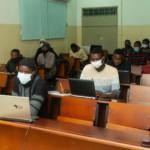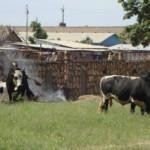
Ulla-Maija Knuutti & Satu Määttänen
Problem-based learning (PBL) is a recommended educational approach to develop 21st-century skills and transformative competences needed in the world of work. PBL promotes active and authentic learning, with learning driven by real-life problem-solving within student teams.
Häme University of Applied Sciences (HAMK) is promoting and championing PBL in sub-Saharan educational institutions through its Africa projects. PBL has aroused huge interest among the African partner institutions. The university staff, both teachers and administrators, have been eager and thrilled to implement PBL. They have developed their own PBL plans for courses (see e.g. Kavwanga et al., 2022; Mulonda et al., 2022), and noticed PBL’s benefits (Hamukwala et al., 2022; Ojok et al., 2022). Some of the project participants, students, and staff alike, have even promoted PBL to other universities within Africa.
However, many of the educators perceive large class sizes and lack of sufficient resources to hinder the adoption and implementation of PBL in their home universities, and universities across Africa. Yet, this does not need to be the case. PBL can be used in many different settings, both with large classes and with minute resources (Amoako-Sakyi & Amonoo-Kuofi, 2015). In this article, based on the main author’s extensive experience as an educator, we provide practical solutions on how to implement PBL with large classes with reasonable effort.
PBL with large classes
PBL is often conducted within rather small student teams, consisting of 5–7 members, and with a tutor guiding the teamwork. It is advisable to increase the number of student teams, rather than to increase the student members within a team.
One tutor can handle more than one student team. To ease the tutor’s work, without compromising the learning, different student teams can do partly combined tasks. For example, student teams can be “brought together” through panel discussions, debates, or a common task, where student teams focus on different dimensions of one topic. The mentor can then monitor and guide the work of all the student teams. With this method, one mentor can supervise quite a large number of students.
However, for the first time using PBL, large class sizes can be a challenge. In these cases, either the number of tutors should be increased, or alternatively one can start reaching PBL step by step by utilizing active learning methods. Active learning refers to various student activities or tasks in which students actively construct and reflect their knowledge and understanding (Brame, 2016). An example of an active learning task is organizing 10-minute group discussions in mini student teams comprising 3–4 members or arranging learning games for students (e.g. Whenham, 2020). After both the teacher and the students have become familiar with active learning strategies and methods, it will become easier to implement pure PBL – even within large classes.
Rubric assessment tools, as well as peer assessment, i.e., students assessing each other, are useful in evaluating and grading large student numbers (Rhodes, 2010). This should not take more time than reading and assessing multiple essays or exams.
Practice makes perfect
A common misconception is that PBL would require a number of physical and monetary resources, such as equipment and field work periods. However, in most cases, PBL can be implemented within classrooms or in online environments with rather minute resources. The main resources needed in PBL are the tutors and their time.
Planning and implementing PBL, especially for the first time, may, and usually will, take more time than just preparing for and holding lectures. Yet, with more experience and established habits, planning and implementing PBL requires less and less time and effort.
Careful preparation goes a long way in implementing PBL. Familiarising with different PBL implementation methods and examples, through for example literature, will save time later, in the actual implementation, as well as in subsequent PBL courses.
It is advisable to reflect on each PBL course – or each PBL task if a hybrid model combining traditional teaching and PBL is used – and update plans for the next course or task accordingly. One can, for example, collect feedback from students, and ponder what went well and what did not, and how things could be done differently next time. Done time and time again, this will reduce the effort needed for PBL implementation.
The saying “practice makes perfect” applies not only to PBL tutors but to students alike. When students face PBL methodology for the first time, they may find it challenging (Abbey et al., 2017; McCowan, 2018), and thus, require a lot of guidance and support from the tutors. However, as students get familiar with the learning method, the more they start to take responsibility for their learning and on the learning task, and the tutors’ workload will subsequently reduce.
Up-scaling problem-based learning
PBL has been proven an efficient method to develop students’ 21st-century skills, and the method has gained more and more popularity around the world. Breaking the assumptions of PBL requiring vast resources can make the practice even more common, especially in countries that struggle with limited educational resources. We hope that this article will encourage and help educators around the world to plan and implement PBL within various of different settings.
Authors
Ulla-Maija Knuutti, M.Sc. In Rural Development from Häme University of Applied Sciences. She works as a Senior Lecturer in HAMK Edu Research Unit.
Satu Määttänen, M.Sc. in Agricultural Sciences and M.Sc. in Environmental Science and Policy from the University of Helsinki. She works as a Research Assistant at Häme University of Applied Sciences in the Bio Research Unit.
References
Abbey, Lord, Dowsett, E., & Sullivan, J. (2017). Use of problem-based learning in the teaching and learning of horticultural production. Journal of Agricultural Education and Extension, 23(1), 61–78. https://doi.org/10.1080/1389224X.2016.1202846
Amoako-Sakyi, D., & Amonoo-Kuofi, H. (2015). Problem-based learning in resource-poor settings: lessons from a medical school in Ghana. BMC Medical Education, 15(221). https://doi.org/10.1186/S12909-015-0501-4
Brame, C. J. (2016). Active Learning. Vanderbilt University Center for Teaching. https://cft.vanderbilt.edu/guides-sub-pages/active-learning/
Hamukwala, P., Kiwanuka-Lubinda, R. N., Syampaku, E. M., Juma, F. L., Määttänen, S., & Laitinen, E. (2022). Educational perspective for solving Zambia’s and Kenya’s dairy value chain challenges. In E. Laitinen, S. Määttänen, & U.-M. Knuutti (Eds.), Problem-based learning & agropreneurship in Africa. HAMK Unlimited Professional, 31.10.2022. https://urn.fi/URN:NBN:fi-fe2022101461980
Kavwanga, Y., Mufungwe, J., Määttänen, S., & Laitinen, E. (2022). Introducing problem-based learning to teach dairy production in Zambia for the first time: A teacher’s perspective. In E. Laitinen, S. Määttänen, & U.-M. Knuutti (Eds.), Problem-based learning & agropreneurship in Africa. HAMK Unlimited Professional, 16.6.2022. https://urn.fi/URN:NBN:fi-fe2022061546614
McCowan, T. (2018). Quality of higher education in Kenya: Addressing the conundrum. International Journal of Educational Development, 60, 128–137. https://doi.org/10.1016/j.ijedudev.2017.11.002
Mulonda, K., Indeche, A., Chabala, L. M., Kaluba, P., Simfukwe, P., Siatwiinda, S. M., Orek, C., Lelei, J. J., Canwat, V., Phiri, E., Määttänen, S., & Laitinen, E. (2022). Application of problem-based learning in higher education in soil and climate change studies in Sub-Saharan Africa. In E. Laitinen, S. Määttänen, & U.-M. Knuutti (Eds.), Problem-based learning & agropreneurship in Africa. HAMK Unlimited Professional, 16.6.2022. https://urn.fi/URN:NBN:fi-fe2022061546651
Ojok, K., Kimatu, J. N., Mutambi, J., Okidi, L., Ruhiu, S., Määttänen, S., & Laitinen, E. (2022). The need for an educational paradigm shift in sub-Saharan Africa. In E. Laitinen, S. Määttänen, & U.-M. Knuutti (Eds.), Problem-based learning & agropreneurship in Africa. HAMK Unlimited Professional, 14.12.2022. https://urn.fi/URN:NBN:fi-fe2022120970258
Rhodes, T. L. (2010). Assessing outcomes and improving achievement : tips and tools for using rubrics. Association of American Colleges and Universities.
Whenham, T. (2020). 15 active learning activities to energize your next college class. https://www.nureva.com/blog/education/15-active-learning-activities-to-energize-your-next-college-class





